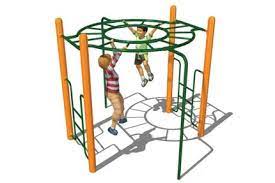
Scaling New Heights: Exploring the Thrills and Benefits of Climbing Structures
Climbing Structures: Unleashing Adventure and Growth
Climbing structures have long been a staple of outdoor play, offering children the opportunity to explore, challenge themselves, and develop a range of important skills. From towering climbing walls to intricate jungle gyms, these structures provide endless possibilities for adventure and growth.
One of the most obvious benefits of climbing structures is the physical activity they offer. Scaling a wall or navigating a challenging obstacle course requires strength, balance, and coordination. As children engage in these activities, their muscles are strengthened, their motor skills are honed, and their overall fitness improves.
But climbing structures offer more than just physical benefits. They also provide valuable opportunities for children to develop their problem-solving abilities and enhance their cognitive skills. When faced with a new route or an unfamiliar challenge, children must strategize, assess risks, and make decisions in real-time. This not only stimulates their critical thinking but also boosts their confidence as they learn to overcome obstacles.
Furthermore, climbing structures foster social interaction and communication among children. Whether it’s taking turns on a rope ladder or collaborating on a team-building exercise, these structures encourage cooperation and teamwork. Children learn to communicate effectively with one another, share ideas, and support each other’s efforts. These social skills are essential for building relationships and navigating the world beyond the playground.
In addition to physical and cognitive development, climbing structures also promote emotional growth. As children push themselves outside their comfort zones and conquer challenges they once thought impossible, they experience a sense of accomplishment and self-confidence. Overcoming fears of heights or mastering a difficult climb instills resilience and determination that carries over into other areas of life.
Safety is paramount when it comes to climbing structures. It’s crucial that these play areas are designed with appropriate safety measures in place to prevent accidents or injuries. Well-maintained equipment, soft landing surfaces like rubber matting or wood chips beneath the structure, proper supervision, and clear guidelines for safe play are essential to ensure children’s well-being.
Climbing structures come in a variety of shapes, sizes, and materials. From traditional metal frames to natural wooden structures, each offers a unique play experience. Some climbing structures incorporate slides, tunnels, or interactive elements to add an extra layer of excitement. The design possibilities are endless, allowing for creativity and innovation in creating engaging play spaces.
Whether found in public parks, schools, or dedicated adventure playgrounds, climbing structures have an enduring appeal. They provide a platform for children to explore their physical abilities, challenge themselves mentally, develop social skills, and build emotional resilience. Through play on climbing structures, children learn valuable life lessons such as perseverance and problem-solving that will benefit them throughout their lives.
So next time you see a climbing structure beckoning with its towering heights and thrilling challenges, encourage your child to step up and embark on an adventure. Watch as they grow stronger physically and mentally while embracing the joy of conquering new heights. Climbing structures truly are the gateway to endless possibilities for fun and personal growth!
7 Essential Tips for Safe Climbing on Structures
- Always wear appropriate safety gear when climbing structures, including a helmet and harness.
- Be sure to check the structure for any loose bolts or other signs of wear and tear before attempting to climb it.
- Make sure you have an experienced spotter with you while climbing, in case you fall or get stuck.
- Always follow the manufacturer’s instructions for use and maintenance of the structure when using it for climbing purposes.
- Take regular breaks while climbing, as this will help prevent fatigue-related accidents or injuries from occurring.
- Ensure that your hands are always clean and free from dirt or grease before attempting to climb a structure, as this can make it more difficult to grip securely onto its surfaces during ascents and descents.
- When descending from a structure, never jump off; instead use controlled movements to lower yourself down safely at all times.
Always wear appropriate safety gear when climbing structures, including a helmet and harness.
Safety First: Gear Up for Climbing Structures
When it comes to climbing structures, adventure and fun are always at the forefront. But amidst the excitement, it’s crucial to prioritize safety. One essential tip that should never be overlooked is wearing appropriate safety gear, including a helmet and harness.
Climbing structures can offer thrilling challenges and opportunities for exploration, but they also involve certain risks. Wearing a helmet is a simple yet effective way to protect your head from potential falls or collisions. It provides an extra layer of cushioning and can greatly reduce the risk of head injuries.
A harness is another vital piece of safety equipment when tackling more advanced climbing structures or high-altitude challenges. A harness secures your body to the structure, ensuring that even if you slip or lose balance, you remain safely attached. This added security can give climbers peace of mind as they navigate various obstacles.
Choosing the right safety gear is just as important as wearing it. Ensure that your helmet fits properly and snugly on your head without obstructing your vision. Look for helmets specifically designed for climbing or other high-impact activities to ensure maximum protection.
Similarly, selecting a well-fitted harness is crucial. It should be adjustable to accommodate different body sizes and shapes while maintaining a secure fit. Always follow manufacturer guidelines when choosing and using safety gear to ensure proper usage.
Remember, wearing safety gear isn’t just about protecting yourself; it sets an example for others too. By demonstrating responsible behavior and prioritizing safety, you encourage those around you to do the same.
Parents and caregivers play an essential role in ensuring children wear appropriate safety gear when engaging with climbing structures. Educate children about the importance of helmets and harnesses from an early age, instilling good habits that will stay with them throughout their lives.
It’s worth noting that while safety gear provides added protection, it does not eliminate all risks associated with climbing structures. Supervision by responsible adults is crucial, particularly for younger children or those new to climbing. Encourage open communication about safety guidelines and remind children to follow them at all times.
So, before embarking on your next climbing adventure, take a moment to gear up. Strap on that helmet, secure that harness, and let the fun begin with peace of mind. By embracing safety measures, you can fully enjoy the excitement and challenges of climbing structures while minimizing potential risks.
Remember: Safety first, adventure always!
Be sure to check the structure for any loose bolts or other signs of wear and tear before attempting to climb it.
Safety First: Checking Climbing Structures for Wear and Tear
When it comes to climbing structures, safety should always be the top priority. Before your child embarks on an exciting climbing adventure, it is crucial to take a moment to inspect the structure for any signs of wear and tear.
One important tip is to check for loose bolts or other potential hazards. Over time, constant use and exposure to the elements can cause bolts to loosen or become damaged. These loose bolts can pose a serious risk if not addressed promptly. Take a close look at the structure and ensure that all bolts are securely fastened.
In addition to checking the bolts, keep an eye out for any other signs of wear and tear. Look for worn-out ropes, frayed edges, or splintered wood. Any of these signs could indicate that the structure may not be safe for climbing.
Regular maintenance and inspections are essential in keeping climbing structures safe for children. If you notice any issues or concerns during your inspection, it is important to report them to the relevant authorities or responsible individuals immediately.
Remember, a quick check before climbing can go a long way in preventing accidents and ensuring a safe play experience for everyone involved. By taking this simple precautionary step, you can enjoy peace of mind knowing that your child’s climbing adventure will be both thrilling and secure.
So next time you visit a playground with climbing structures, take a moment to inspect them carefully. By being vigilant about safety and addressing any potential risks promptly, we can create an environment where children can explore their physical abilities with confidence and joy.
Make sure you have an experienced spotter with you while climbing, in case you fall or get stuck.
Climbing Structures: The Importance of a Trusty Spotter
When it comes to climbing structures, safety should always be a top priority. While these structures offer an exhilarating adventure, it’s essential to have precautions in place to ensure a secure and enjoyable experience. One crucial tip to remember is the importance of having an experienced spotter by your side.
A spotter is someone who can assist and support you while you climb, offering guidance and help if needed. Their role is to keep a watchful eye on your progress, ensuring that you have a safety net in case of any mishaps such as falls or getting stuck.
Having an experienced spotter provides numerous benefits when tackling climbing structures. Firstly, they can offer valuable advice on technique and route selection, helping you navigate the structure effectively. Their knowledge and experience can save you time and energy by pointing out the best paths and grips to use.
Moreover, a spotter acts as an extra set of eyes, identifying potential hazards or obstacles that may not be immediately apparent to you. They can warn you about loose holds or areas where extra caution is required. With their assistance, you can make informed decisions about your next move, minimizing the risks involved.
In case of any unexpected situations like slipping or losing balance, a spotter is there to provide immediate support. They can help break your fall or guide you back onto the climbing structure safely. This not only prevents injuries but also instills confidence knowing that someone is there to assist if things don’t go as planned.
It’s important to choose an experienced spotter who understands the nuances of climbing structures and has knowledge of proper spotting techniques. They should be attentive, focused, and ready to react swiftly if necessary. Communication between climber and spotter is key – establishing clear signals or verbal cues ensures effective coordination throughout the climb.
Remember that even with a trusted spotter present, it’s crucial to exercise caution and follow safety guidelines. Climbing structures should be used within your abilities, and it’s always wise to start with easier routes before progressing to more challenging ones. Proper use of safety equipment, such as helmets and harnesses where applicable, should also be considered.
So, before you embark on your climbing adventure, make sure you have a reliable spotter by your side. Their presence offers peace of mind, allowing you to focus on the thrill and excitement of conquering new heights. With their guidance and support, you can climb with confidence, knowing that someone has got your back.
Climbing structures provide endless opportunities for growth, learning, and fun. By incorporating the tip of having an experienced spotter with you, you can ensure a safe and enjoyable climbing experience that will leave you with lasting memories. So gear up, find your spotter, and get ready for an incredible adventure!
Always follow the manufacturer’s instructions for use and maintenance of the structure when using it for climbing purposes.
Climbing Structures: Safety First!
When it comes to climbing structures, safety should always be the top priority. One important tip to ensure a safe and enjoyable experience is to follow the manufacturer’s instructions for use and maintenance of the structure.
Manufacturers design climbing structures with specific guidelines in mind, taking into account factors such as weight capacity, proper usage, and recommended maintenance. By adhering to these instructions, you can help minimize the risk of accidents or damage to the structure.
Before allowing children to climb on a structure, take the time to familiarize yourself with the manufacturer’s guidelines. These instructions often include information on age restrictions, maximum weight limits, and recommended supervision levels. It’s essential to ensure that children using the structure are within the specified age range and meet any other requirements outlined by the manufacturer.
Regular maintenance is also crucial for keeping climbing structures safe. Manufacturers typically provide recommendations on inspecting and maintaining their products. This may involve checking for loose bolts or screws, ensuring that safety features like handrails are secure, and periodically cleaning or repairing any wear and tear.
By following these instructions diligently, you can help keep climbing structures in optimal condition while ensuring that children can enjoy them safely. It’s also essential to stay vigilant during use and address any potential hazards promptly. If you notice any damage or unsafe conditions on a climbing structure, report it immediately so that necessary repairs can be made.
Remember, climbing structures offer fantastic opportunities for physical activity, skill development, and fun adventures. By following the manufacturer’s instructions for use and maintenance, you’re taking an important step towards creating a safe environment where children can thrive and explore their abilities.
So let’s make safety our priority when it comes to climbing structures! Together, we can create a world of fun-filled adventures while keeping our little climbers secure every step of the way.
Take regular breaks while climbing, as this will help prevent fatigue-related accidents or injuries from occurring.
Climbing Structures: The Importance of Taking Regular Breaks
When it comes to climbing structures, the exhilaration and excitement can sometimes make us forget about the importance of taking breaks. However, incorporating regular breaks into your climbing routine is essential for maintaining safety and preventing fatigue-related accidents or injuries.
Climbing requires physical exertion and concentration. As you navigate through obstacles, scale heights, and push your limits, your muscles are working hard, and your mind is focused on the task at hand. Without proper rest periods, fatigue can set in, leading to decreased alertness and coordination.
Taking regular breaks allows your body to recover and recharge. It gives your muscles a chance to relax and reduces the risk of strain or overuse injuries. By allowing yourself moments of rest, you give your body time to replenish energy stores and prevent muscle fatigue.
Moreover, breaks provide an opportunity for self-assessment and reflection. Pausing during a climb allows you to evaluate your performance so far, assess any potential risks or challenges ahead, and plan your next moves accordingly. This mental break can help maintain focus while reducing the chances of making impulsive decisions due to tiredness.
In addition to physical recovery and mental clarity, breaks also promote social interaction among climbers. Gathering with fellow climbers during rest periods encourages camaraderie, sharing experiences, and exchanging tips or strategies. It creates a supportive environment where everyone looks out for each other’s well-being.
So how often should you take breaks while climbing? The frequency may vary depending on factors such as the intensity of the climb or personal fitness levels. As a general guideline, aim for short breaks every 10-15 minutes of continuous climbing activity. Use this time to hydrate, catch your breath, stretch if needed, and assess the condition of both yourself and your equipment.
Remember that safety should always be a priority when engaging in any physical activity. Climbing structures are designed for fun and adventure, but it’s crucial to approach them with caution and respect. Taking regular breaks not only helps prevent fatigue-related accidents or injuries but also allows you to fully enjoy the experience while staying safe.
So the next time you embark on a climbing adventure, remember to listen to your body and take those well-deserved breaks. By doing so, you’ll ensure that your climbing experience remains enjoyable, safe, and injury-free. Happy climbing!
Ensure that your hands are always clean and free from dirt or grease before attempting to climb a structure, as this can make it more difficult to grip securely onto its surfaces during ascents and descents.
Climbing Structures: Clean Hands for Safe Adventures
When it comes to climbing structures, safety should always be a top priority. One simple tip that can make a big difference is to ensure that your hands are clean and free from dirt or grease before attempting to climb. This may seem like a small detail, but it can greatly impact your ability to grip securely onto the surfaces during ascents and descents.
Clean hands provide better traction and grip, allowing you to maintain control and stability as you navigate the structure. Dirt or grease on your hands can create a slippery surface, making it more challenging to hold on firmly. By taking just a moment to wash your hands or wipe them clean before climbing, you can enhance your overall climbing experience and reduce the risk of slipping or losing control.
Not only does clean hands improve safety, but they also contribute to the durability of climbing structures. Grease or dirt residue left behind by climbers can accumulate over time, leading to a build-up that affects the integrity of the surfaces. Regularly cleaning your hands helps preserve the structure’s quality and ensures that future climbers can enjoy it in its best condition.
So, before embarking on your next climbing adventure, take a quick trip to the nearest restroom or carry hand wipes with you. Ensure that your hands are free from any dirt, grime, or grease. This small act of preparation will go a long way in enhancing your grip, maintaining control, and keeping yourself and others safe while enjoying the thrill of climbing.
Remember, climbing structures offer endless opportunities for fun and growth. By keeping our hands clean and ready for action, we can fully embrace these adventures with confidence and peace of mind. So let’s make cleanliness an essential part of our climbing routine and enjoy every ascent and descent with secure grips!
Stay safe, keep those hands clean, and have an amazing time exploring the world of climbing structures!
When descending from a structure, never jump off; instead use controlled movements to lower yourself down safely at all times.
Safety First: Descending from Climbing Structures with Care
When it comes to enjoying climbing structures, safety should always be a top priority. While the thrill of reaching the top can be exhilarating, it’s equally important to know how to descend safely. Remember, when leaving a climbing structure, never jump off. Instead, use controlled movements to lower yourself down safely at all times.
Jumping off a climbing structure can lead to unnecessary risks and potential injuries. The impact of landing from a height can strain joints and bones, causing sprains or even fractures. Additionally, landing on uneven surfaces or colliding with other objects or children can further escalate the risk of accidents.
To ensure a safe descent, follow these simple steps:
- Assess the structure: Take a moment to evaluate the climbing structure before you begin descending. Look for designated exit points or areas that are designed for safe departure.
- Find secure handholds: Locate sturdy handholds or grips that you can use as support while lowering yourself down. These could be bars, ropes, or any other secure fixtures available on the structure.
- Maintain control: As you begin your descent, maintain control of your movements at all times. Avoid rushing or sliding down too quickly, as this increases the chances of losing balance and falling.
- Use your legs: Engage your leg muscles by bending your knees slightly and using them as shock absorbers while descending. This helps cushion your landing and reduces strain on your joints.
- Slide or climb down: Depending on the design of the structure, you may need to slide down gently or climb down using appropriate handholds and footholds provided. Follow any guidelines or instructions posted on the structure for a safe descent.
- Communicate with others: If there are other children or individuals also descending from the structure, communicate clearly to ensure everyone is aware of each other’s movements and maintains a safe distance.
Remember that adult supervision is crucial when children are using climbing structures. Encourage them to follow these safe descent practices and provide guidance as needed.
By prioritizing controlled movements and safe descents, we can minimize the risk of accidents and injuries while enjoying the excitement of climbing structures. Let’s make every playtime a fun and safe experience for all!



